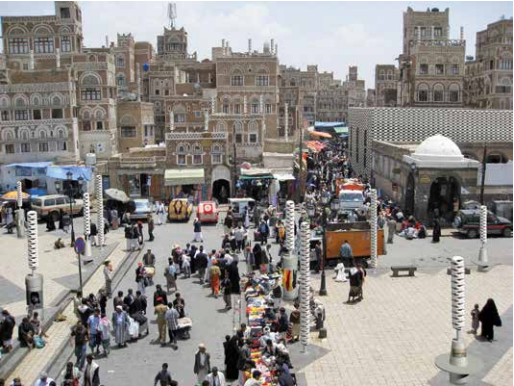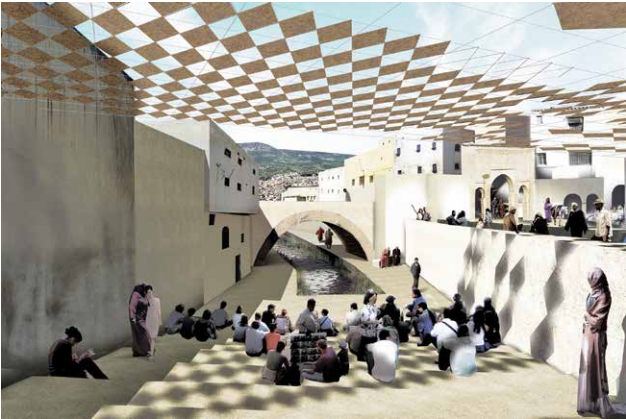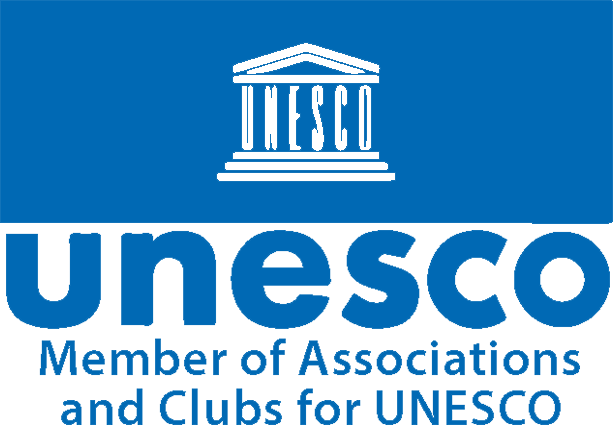Introduction
The traditional form of cities in the Middle East has been intimately intertwined with water, a resource on which the very life and survival of these cities rely upon. For instance, in the medieval Arab Cities, or Medinas, the water network composed of public fountains, ablution basins, wells, mills and sewage systems, are enmeshed with the urban fabric, often guiding its form and growth. Conversely, in arid regions of the Middle East such as Saharan oases, sophisticated system of underground channels (Quanat) coupled with reservoirs and irrigation canals (Seguias) have been developed to both sustain the agricultural landscape of the oasis and secure water to the population. Today, the situation has changed. Amid the expansion of arid zones, large per capita water demand and a natural lack of freshwater2 , Middle Eastern cities are facing a looming water crisis. Yet, urban form, landscapes and buildings often treat water infrastructure as a de facto, static entity, which falls within the realm of the engineering disciplines. In fact, the conventional infrastructural model for water is based on a centralized network both providing tap water and collecting and treating wastewater. In this model, the role of water infrastructure vis a vis the design of cities, buildings and landscapes remains immutable, while in parallel, water technologies are flourishing at each scale, from moisture sensing at precise points in space and time to modeling of complex water systems at industrial, urban, regional, and planetary scales. Hence, this parallel tracks between the engineering and design disciplines are disallowing not only the rethinking of new built environments and their water infrastructure, but also a smart retrofit of existing cities and urban regions which have been unable to address waterrelated flood, drought, and pollution hazards.
What this essay would like to argue is that the co-option 9 of water infrastructure by the design disciplines, namely architecture, urban planning and landscape architecture, will reveal new ways to conceive the future of built environments in the Middle East, namely by increasing efficiency, reducing cost and limiting environmental impact. This redefinition is characterized not only by the integration of water infrastructure and supporting innovative technologies with designers’ creative and analytical processes, but also by embracing an expanding definition of water including sewage water, saline water, fog and ambient humidity. Two innovative projects of different scales, one set in Fez, Morocco and the other in Sanaa, Yemen, will illustrate the potential for Middle Eastern cities of such an approach towards water infrastructure.
Infrastructure and the design disciplines
Within the design disciplines today, the term ‘urban infrastructure’ encompasses a multitude of different elements ranging in scales and typologies from national energy systems, regional transportation networks, electric grids to domestic water pipes. Interestingly, all these various typologies share the legacy of the discipline of engineering and the discourse on networks from Saint Simonianism3 to Large Technical Systems theories4 , whose underlying goals were performance, efficiency and interconnection of immaterial and physical networks for the collective wellbeing. Furthermore, infrastructure has been a pervasive theme in 20th century architectural discourse in its definition vis a vis the City. Indeed, the integration of mechanical systems including HVAC, electricity and heating and in a lesser degree plumbing, have been part of a recurring debate in the 20thth century in the architectural academe. This debate wavered between the camouflaging or celebrating of the innards of a building. For instance Le Corbusier famously hated tubes and painstakingly hid them in his buildings, while Reyner Benham’s full heartedly embraced buildings’ mechanical systems to the detriment of the rest. Similarly, Renzo Piano and Richard Rogers exposed on the façade of Beaubourg colorful pipes, each referring to a mechanical function.
From the perspective of urbanists and cultural geographers, the relationship between water and urban space can be understood by the emergence of what Matthew Gandy coins “the ‘bacteriological city’, defined by features such as new moral geographies and modes of social discipline based upon ideologies of cleanliness”.5 This model is based on a technocratic and rational model of municipal managerialism, which echo the modernist vision of city as a living, metabolic machine. By the 1970’s, this model failed to be implemented by most cities that ended adopting a more diffuse, fragmentary and polarized urban water technological landscape, in which public interest came second to stakeholders’ and in which designers had little to no involvement.
It is only recently that the integrative co-option of infrastructure by the design disciplines on a multi-scalar level has taken place; a trend heralded by Rem Koolhas’ seminal 1994 essay “What Ever Happened to Urbanism” (1994), by MVRDV’s Farmax (1998), the work of Charles Waldheim on landscape urbanism (2006) and the publication Architecture as Infrastructure (2010) to name a few. This expanded agency of the architect has been further exacerbated by the ‘sustainable design’ buzz whose advocates aspire to efficient and low footprint infrastructure. Most recently, the boom of innovative sustainable cities and neighborhoods in the Middles East, such as Foster’s Masdar and Xeritown by X Architect, has spurred the rethinking of urban infrastructure, including wastewater and drinking networks; thus enabling new grounds for cross breeding between different infrastructural systems.
If theses projects rethink urban infrastructure as a legitimate ground for investigation and action in order to sustainably transform the city, rather than take infrastructure as an immutable foundation. While the physical, economic and social impacts on the metropolis and its landscape are brought to the forefront, what is still under-studied is the place of technology associated with these new infrastructural models. In fact, while infrastructure armatures are used as platforms for design innovations and speculations, often their related technologies are taken as add on components rather than assets with synergetic capacity. Therefore, the intersection of water infrastructures with the design disciplines would profit from converging the modus operandi of water technologies for collecting/ converting/ distributing with their position within different water networks models, either existing or new.
In this new paradigm, water technology could best described in Heideggerian terms, as it considers its simultaneous role as a “techne”, a know how/ system of practical knowledge, and a “poiesis”, “a way of bringing-forth or revealing not in itself”6 , but in the designer. In other words, technology is about the “action and the reflection-in-action”.7 This dual definition is even the more relevant for addressing water technologies, since water, unlike other technologies such as heating, cooling or electricity, is a tangible, sensual resource strongly reminiscent of nature in the collective imaginaries
Case Study 1: Vena
The first illustrative example of this new approach to water infrastructure is Vena, a free standing device which collects, stores and provides water to off the grid users in the city of Sanaa, a city facing a sever water crisis. Indeed, Yemen counts a mere 125 cubic meters per capita; a number much lower than the average for the MENA region (1,000 cubic meters per person which is the point at which a nation is bracketed as being water poor.)
Developed by Ore Design + Technology, Vena rethinks water infrastructure as an autonomous system, disengaged from a centralized controlling core, and relying only on its vapor collection mechanism to provide water to users. In fact, Vena leverages high temperature differential in arid climates to trigger the condensation of relatively cooler vapor found below ground. The thermally conductive central copper cable stretches up the entire length of the structure. It unravels a network of densely arranged filaments, which penetrate through a perforated stainless steel tube, thus exposing the cooled surface area of vapor condensation. External ceramic discs protect the internal systems from heat gain and evaporation, while channeling prevailing winds. A ceramic enclosure base funnels condensation into the well. For example, at 30 degrees Celsius with 60% humidity, a cubic meter of air contains 18 grams of water.
Architecture & Art As the temperature of the copper filaments decreases by 5-15 degrees Celsius, 35% of the vapor condenses and drains into a cistern or a well. When deployed across the urban context of Sanaa (fig.1), Vena pole like structure support street furniture and are connected to collective water reservoirs. These reservoirs provide water to the city dwellers and could be either directly connected to dwellings or directly accessible.
The Vena network not only supplements the scarce water resources of Sanaa, but also acts as a catalyst for a new type of public spaces, in which water collecting mechanisms are on display, hopefully raising awareness towards water conservation. At last, by creating an autonomous, heterotopic water infrastructure, this project embodies a new typology of resilient water infrastructure: if one of its unit fails, it will continue to perform.

Case Study 2: Fez River Project
Unlike Vena which imagines a new way to collect and store water, the Fez River project by Bureau E.A.S.T. improves and retrofits an existing, conventional centralized water infrastructure, and simultaneously investigates the programmatic opportunities offered by newly introduced water technologies. In fact, the project simultaneously restores a polluted urban river and addresses issues endemic to aging medieval fabrics in the Middle East such as the scarcity of public open space, overcrowding, the contamination of natural resources, the destruction of places of cultural and historic significance, and a weak economy. Working with the RADEEF (City of Fez Department of Water and Power) and through a detailed analysis of the medina and its broader urban and ecological context, the project choreographs a phased implementation strategy in which measures for enhancing water quality becomes both the locus and agent for addressing both the social and economic concerns of a city. The project works at two scales – the city scale and the site scale. At the city scale (including both the Ville Nouvelle and the medina), the project is a master plan with recommended measures for improving regional water quality. Depending on soil geomorphology, levels of water pollution, adjacent urban fabric and ecological systems, different rehabilitation tactics are purposefully located, such as canal restorers, constructed wetlands, bank restoration, and storm-water retention ponds. At site scale (parcels within the medina), the project is three critical interventions strategically phased to enhance water quality, remediate contaminated sites and create open spaces. While daylighting the northern part of the river, the three interventions also take advantage of vacant sites to reestablish its connection with the city fabric. The intervention at the Rcif will link a major transportation hub with a riverbank pedestrian circulation system while filtering storm water run-off (fig.2.) Coupled with a constructed wetland, the intervention at the Andalous site will offer a playground. Finally, the intervention at the soon to be defunct and highly contaminated Chouarra tanneries will provide residents and visitors with a new regional botanical garden and an institute for cultivating new designs and technologies related to an already existing but stagnant leather industry. The overall effect is a project that elevates rivers and their decontamination technologies to a form of urban infrastructure with the potential to stitch disjuncture between the needs of a twenty-first century population and the preservation of a unique urban form.

Conclusion
By integrating water infrastructure and their associated technologies within the design process of Middle Eastern cities, these two case studies highlight the salient roles they could hold beyond collecting, storing and distributing water, namely: generating public spaces, spurring awareness for water conservation and fostering urban renewal. Furthermore, the renegotiation of water infrastructure along the development of old and new cities generates a resilient urban model, reminiscent of Kevin Lynch’s ‘Good City’: “open, accessible, decentralized, diverse, adaptable, and tolerant to experiment.”
However, if this approach appears promising to advance a sustainable future for Middle Eastern cities, most of which are located in arid to hyper arid climates and suffer already from water scarcity, it is not a panacea. It will not be effective if not coupled with users’ education and most importantly, with the establishment of effective and legitimate forms of urban governance and policy. At the wake of the Arab Spring and its political changes and renewed agendas, we can only hope that such pressing concerns will be given a priority.
Published in 2A Magazine# 26, Winter 2014

